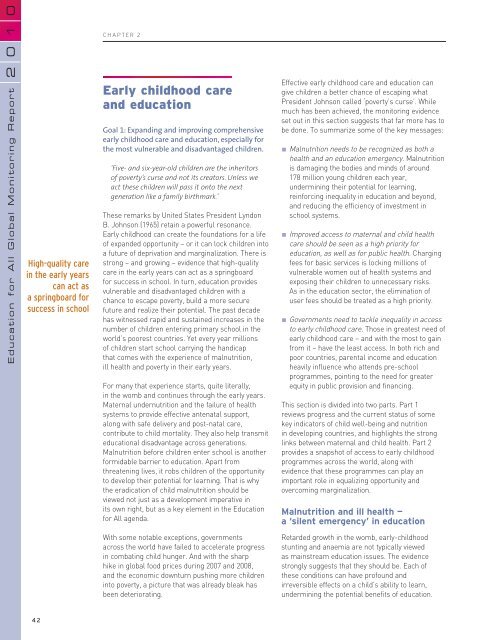Chapter 2. Progress towards the EFA goals - Unesco
Chapter 2. Progress towards the EFA goals - Unesco
Chapter 2. Progress towards the EFA goals - Unesco
Create successful ePaper yourself
Turn your PDF publications into a flip-book with our unique Google optimized e-Paper software.
0<br />
1<br />
2<br />
0<br />
CHAPTER 2<br />
Education for All Global Monitoring Report<br />
High-quality care<br />
in <strong>the</strong> early years<br />
can act as<br />
a springboard for<br />
success in school<br />
Early childhood care<br />
and education<br />
Goal 1: Expanding and improving comprehensive<br />
early childhood care and education, especially for<br />
<strong>the</strong> most vulnerable and disadvantaged children.<br />
‘Five- and six-year-old children are <strong>the</strong> inheritors<br />
of poverty’s curse and not its creators. Unless we<br />
act <strong>the</strong>se children will pass it onto <strong>the</strong> next<br />
generation like a family birthmark.’<br />
These remarks by United States President Lyndon<br />
B. Johnson (1965) retain a powerful resonance.<br />
Early childhood can create <strong>the</strong> foundations for a life<br />
of expanded opportunity – or it can lock children into<br />
a future of deprivation and marginalization. There is<br />
strong – and growing – evidence that high-quality<br />
care in <strong>the</strong> early years can act as a springboard<br />
for success in school. In turn, education provides<br />
vulnerable and disadvantaged children with a<br />
chance to escape poverty, build a more secure<br />
future and realize <strong>the</strong>ir potential. The past decade<br />
has witnessed rapid and sustained increases in <strong>the</strong><br />
number of children entering primary school in <strong>the</strong><br />
world’s poorest countries. Yet every year millions<br />
of children start school carrying <strong>the</strong> handicap<br />
that comes with <strong>the</strong> experience of malnutrition,<br />
ill health and poverty in <strong>the</strong>ir early years.<br />
For many that experience starts, quite literally,<br />
in <strong>the</strong> womb and continues through <strong>the</strong> early years.<br />
Maternal undernutrition and <strong>the</strong> failure of health<br />
systems to provide effective antenatal support,<br />
along with safe delivery and post-natal care,<br />
contribute to child mortality. They also help transmit<br />
educational disadvantage across generations.<br />
Malnutrition before children enter school is ano<strong>the</strong>r<br />
formidable barrier to education. Apart from<br />
threatening lives, it robs children of <strong>the</strong> opportunity<br />
to develop <strong>the</strong>ir potential for learning. That is why<br />
<strong>the</strong> eradication of child malnutrition should be<br />
viewed not just as a development imperative in<br />
its own right, but as a key element in <strong>the</strong> Education<br />
for All agenda.<br />
Effective early childhood care and education can<br />
give children a better chance of escaping what<br />
President Johnson called ‘poverty’s curse’. While<br />
much has been achieved, <strong>the</strong> monitoring evidence<br />
set out in this section suggests that far more has to<br />
be done. To summarize some of <strong>the</strong> key messages:<br />
Malnutrition needs to be recognized as both a<br />
health and an education emergency. Malnutrition<br />
is damaging <strong>the</strong> bodies and minds of around<br />
178 million young children each year,<br />
undermining <strong>the</strong>ir potential for learning,<br />
reinforcing inequality in education and beyond,<br />
and reducing <strong>the</strong> efficiency of investment in<br />
school systems.<br />
Improved access to maternal and child health<br />
care should be seen as a high priority for<br />
education, as well as for public health. Charging<br />
fees for basic services is locking millions of<br />
vulnerable women out of health systems and<br />
exposing <strong>the</strong>ir children to unnecessary risks.<br />
As in <strong>the</strong> education sector, <strong>the</strong> elimination of<br />
user fees should be treated as a high priority.<br />
Governments need to tackle inequality in access<br />
to early childhood care. Those in greatest need of<br />
early childhood care – and with <strong>the</strong> most to gain<br />
from it – have <strong>the</strong> least access. In both rich and<br />
poor countries, parental income and education<br />
heavily influence who attends pre-school<br />
programmes, pointing to <strong>the</strong> need for greater<br />
equity in public provision and financing.<br />
This section is divided into two parts. Part 1<br />
reviews progress and <strong>the</strong> current status of some<br />
key indicators of child well-being and nutrition<br />
in developing countries, and highlights <strong>the</strong> strong<br />
links between maternal and child health. Part 2<br />
provides a snapshot of access to early childhood<br />
programmes across <strong>the</strong> world, along with<br />
evidence that <strong>the</strong>se programmes can play an<br />
important role in equalizing opportunity and<br />
overcoming marginalization.<br />
Malnutrition and ill health —<br />
a ‘silent emergency’ in education<br />
With some notable exceptions, governments<br />
across <strong>the</strong> world have failed to accelerate progress<br />
in combating child hunger. And with <strong>the</strong> sharp<br />
hike in global food prices during 2007 and 2008,<br />
and <strong>the</strong> economic downturn pushing more children<br />
into poverty, a picture that was already bleak has<br />
been deteriorating.<br />
Retarded growth in <strong>the</strong> womb, early-childhood<br />
stunting and anaemia are not typically viewed<br />
as mainstream education issues. The evidence<br />
strongly suggests that <strong>the</strong>y should be. Each of<br />
<strong>the</strong>se conditions can have profound and<br />
irreversible effects on a child’s ability to learn,<br />
undermining <strong>the</strong> potential benefits of education.<br />
42
















